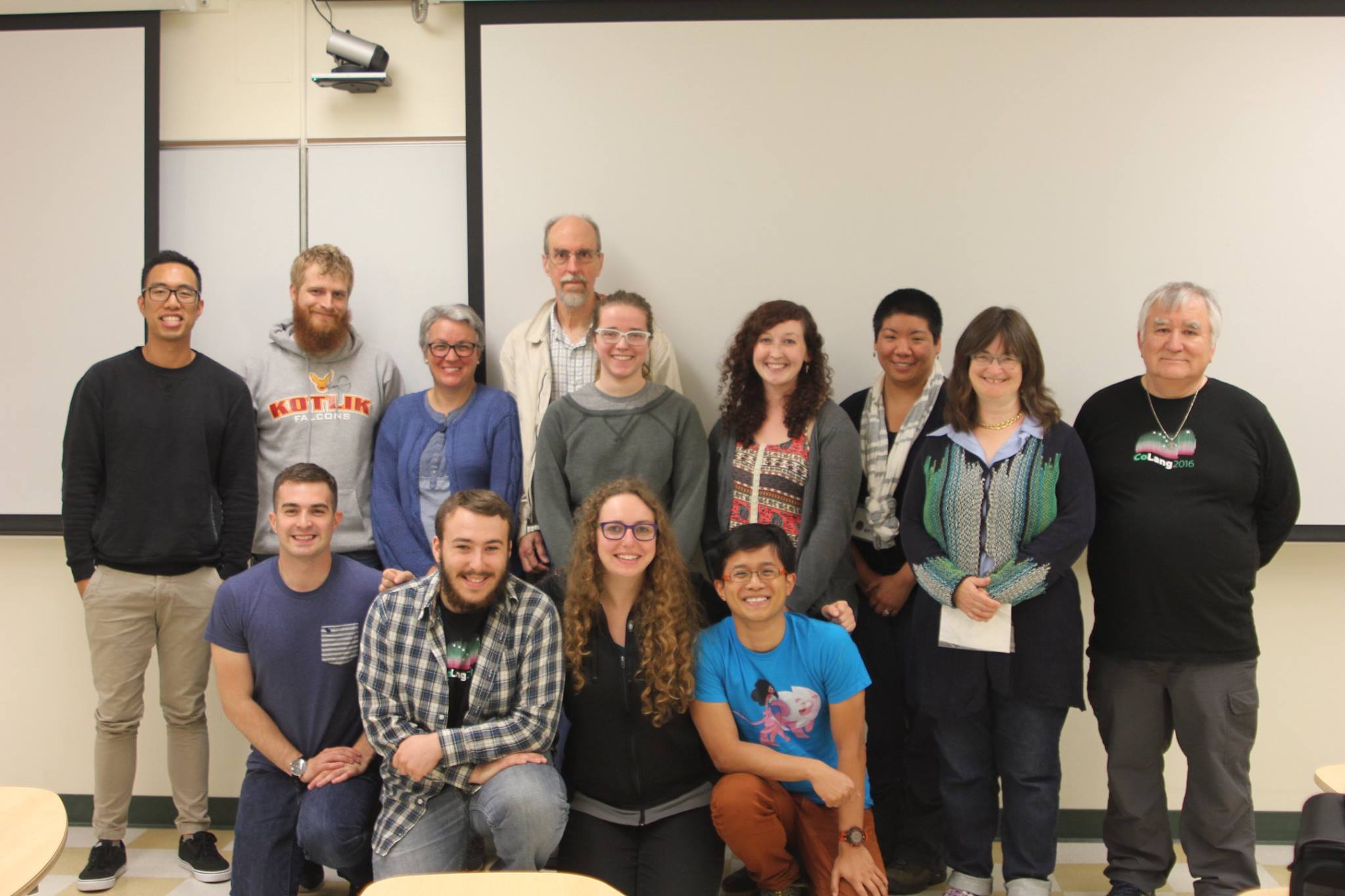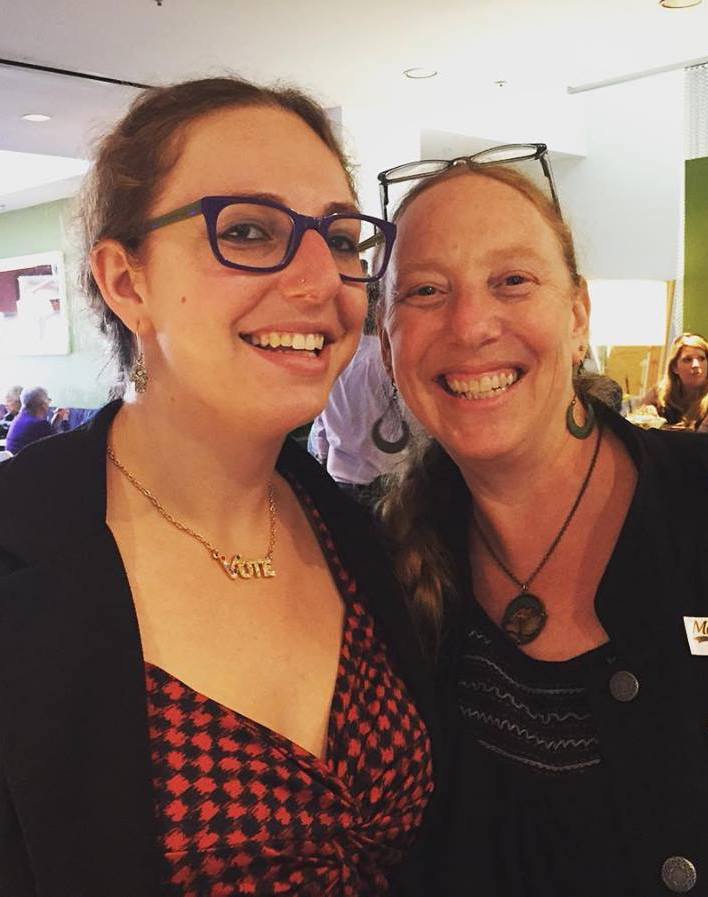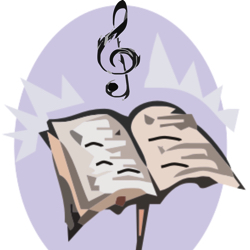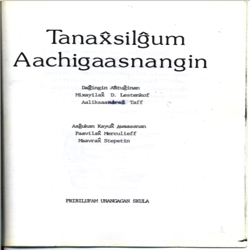About This Project
Language and history through music.
This project came out of CoLang 2016, the Institute on Collaborative Language Research. A group of students, linguists, and activists used the archives available at the University of Alaska Fairbanks to study Unangam Tunuu (Aleut language). We worked with native speaker and teacher, Moses Dirks, from Atka.
Because we were working with these archival materials, we wanted to make them more easily available to the Aleut community, as well as to other linguists, by placing them online. This website is intended as a resource. No part of it may be used for financial gain. We are very open to feedback and suggestions from the Aleut community.
This site aims to make a sampling of songs from the Alaska Native Language Archive available and accessible to the community, language learners and teachers, linguists, musicologists, and anyone else who might appreciate them.

2016 CoLang Unangam Tunuu Practicum with our teachers, Anna Berge and Moses Dirks.
About Me

Me and my mother, Eva.
My name is Maya Wax Cavallaro. I grew up in Massachusetts, and currently live in Los Angeles, California. My parents are Eva Wax and Lenny Cavallaro. I am Ashkenazi Jewish. I am a graduate student at California State University Northridge, where I am working on my MA in linguistics. My studies are focused on sociocultural linguistics and language documentation and revitalization. I found my passion for languages while living and working in Guatemala (or Guatemaya).
Before shifting my academic focus to language, I studied musicology, law, and politics at Oberlin College in Ohio. I am eager to learn more about ethnomusicology and excited to combine musicology and linguistics in my research. I am still involved in political activism.

lokanin discs

dance songs

tanax̂silĝum aachigaasnangin
Why songs?
Language revitalization through music.
This project came out of the 2016 Institute on Collaborative Language Research (CoLang), whose focus is language documentation and revitalization. Why, then, have I created an online collection of music?
There are many reasons to document music that are similar to the reasons for which we document languages. Musical traditions can teach us a great deal about a people’s culture and worldview, in addition to adding to our understanding of musical diversity. Music is also a beautiful form of artistic expression. As musical traditions disappear, they take with them important cultural knowledge, but this is the concern of community members and ethnomusicologists, not necessarily linguists.
Language, however, does not occur in a vacuum. Language and culture are intrinsically tied together, just as music and culture are, and language is quite often a part of musical expression. The interplay between language and music can teach us a great deal, and can even reveal vital aspects of linguistic structure that linguists may otherwise overlook, particularly with regards to phonology.
Music can also be a tremendous teaching tool. Music activates parts of the brain that are not activated by language alone, and can make learning easier for many students. Songs, even those with vocables (nonsense words) and no vocabulary or grammar can help language learners get used to the sounds and patterns of a language. Use of both traditional and contemporary songs in language teaching is also an important way to incorporate culture into lessons, and to demonstrate some of the expressive and artistic applications of a language.
This website aims to make some Unangax̂ (Aleut) songs more available and accessible than they were before. It can be used by linguists or musicologists for analysis and research, by teachers and learners to improve language skills such as phonological awareness, morphosyntactic structures and vocabulary, and by community members who are interested in hearing their heritage language in song and the musical traditions of their ancestors.
If you have any songs (recordings, lyrics, sheet music, or any other format) that you would like to share in this collection, or if you have any questions, comments, or corrections, please contact me.
Transcribing the music
Processes and challenges.
The use of modern Western musical notation to transcribe any type of folk music is a bit complicated and can even be controversial. Music that is learned and passed down through an oral tradition often does not fit neatly into the key and time signatures of Western art music, nor should it have to. It is a different musical genre, culture, and tradition.
The purpose in attempting to transcribe some of these melodies is to make the music accessible to as many people as possible, and to help people who want to reproduce the songs by singing or playing instruments. I found no evidence of a native or alternative musical notation system in the archives, and I did find some use of modern staff notation. As Western staff notation is widely used and understood throughout the entire world, I chose to use it for these transcriptions.
Some musicologists have adopted symbols to indicate details of traditional music, such as pitches that are slightly higher or lower than indicated on the staff. I chose to keep the transcriptions broader. They give the reader a sense of the melody, but are meant to accompany the sound files in the archives.
Some challenges...
1. As I mentioned above, often pitches and rhythms in these archival recordings do not fit neatly into the European scales and time signatures. This can be due to a number of factors, ranging from different scales to damaged recordings to amateur performers. The melodies I have transcribed are merely outlines of the basic rhythmic and melodic shape. They are far from exact.
2. As recordings age, or as they are restored and digitized, pitches and tempi can easily become warped. See the "Chipmunk Hypothesis" for example. When in doubt, I have just opted to transcribe every tune in C Major.
3. So far in all of the Unangan songs with repeating verses, the rhythms and sometimes time signatures and/or melodies seem to change to fit the text. Each repetition of the basic melody, therefore, sounds slightly different.
4. Transcribing the music and text can be very difficult due to poor recording quality and/or damaged recordings. Sometimes it is simply difficult to make out the rhythm, pitches, and/or lyrics.
Txin Qaĝaasakuqing!
Thank you!
This project would not be possible without our teachers Anna Berge and Moses Dirks.
Moses is a native speaker of Unangam Tunuu from Atka Island, and he is a true expert on the language. I am so grateful to him for all of the time he spent with each of us during our Unangam Tunuu practicum. His transcriptions and translations are absolutely essential to all of this work. Txin qaĝaasakuqing!
Thank you to Anna Berge for teaching us about the history of linguistic study of Unangam Tunuu, as well as the structure of the language, and the workings of the Alaska Native Language Archive.
Thank you to Alice Taff for sharing her work and insight, and to Leslie McCartney, Siri Tuttle, and everyone at the UAF Alaska & Polar Regions Archive and Alaska Native Language Archive for teaching us how to work with archives and helping us to access materials.
Thank you to Mike Livingston at the Aleutian Pribilof Islands Association for the support and access to recordings and photos.
I am very grateful to the families of Willie Tcheripanoff and Mike and Paroscovia Lokanin for sharing their music.
Finally thank you to the linguists, activists, speakers, language warriors, University of Alaska faculty and staff, and everyone who helped to make CoLang 2016 happen!
This material is based upon work supported by the National Science Foundation under Grant No. #1500841. Any opinions, findings, and conclusions or recommendations expressed in this material are those of the author(s) and do not necessarily reflect the views of the National Science Foundation.
These materials may not be sold and no charges may be made for their use.





